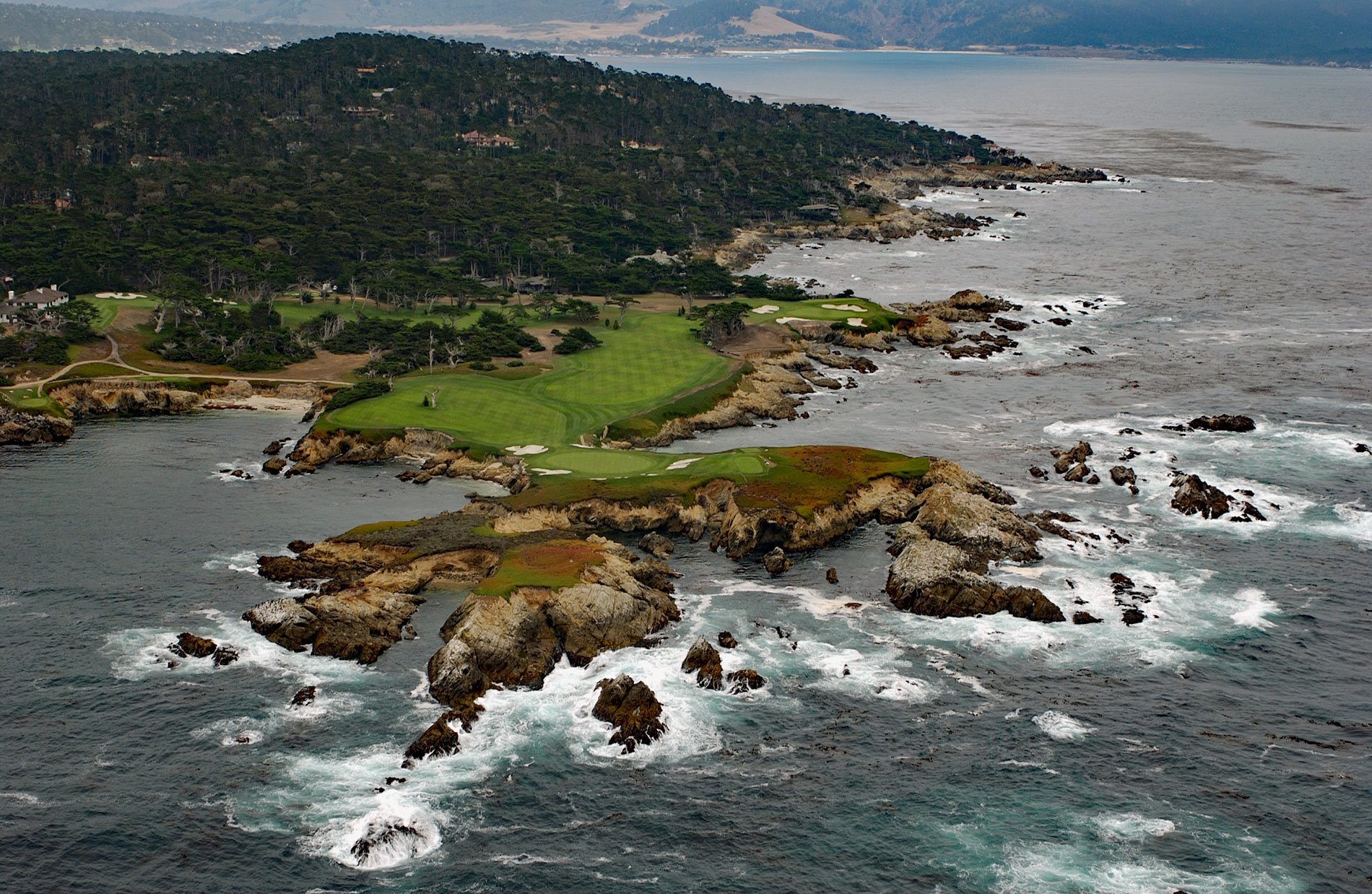Cypress Point is the westernmost headland on the Monterey Peninsula, about 4.5 miles (7.3 km) southwest of Monterey and 3.5 miles (5.5 km) northwest of Carmel, California. The Monterey Peninsula is named after Monterey Bay and is located on the central California coast and now includes the cities of Monterey, Carmel, Pacific Grove, and unincorporated areas such as the resort and community of Pebble Beach. The first European to discover Monterey Bay was the Spaniard Juan Rodríguez Cabrillo on November 16, 1542, while sailing northward along the coast. He named the bay Bahía de Los Pinos, probably because of the forest of pine trees first encountered while rounding the peninsula at the southern end of the bay. Cabrillo’s name for the bay was lost, but the westernmost point of the peninsula is still known as Point Pinos. On December 10, 1595, Sebastián R. Cermeño crossed the bay and bestowed the name Bahía de San Pedro in honor of Saint Peter Martyr. The present name for the bay was given in 1602 by Sebastián Vizcaíno, who had been tasked by the Spanish government to complete a detailed chart of the coast. Point Cypress is named after the Monterey cypress. In 1774, Tomas de la Pena called it Punta del Cipreses in his diary kept during the voyage of the frigate Santiago to the northwest coast of North America and it is so named on several maps. The western shoreline of the Monterey Peninsula south to Cypress Point is characterized by rocky headlands and small pocket beaches, some of which are backed by dune fields or a low marine terrace, and the offshore sediment is sparse. The Cypress Point Fault runs parallel to the coast between Cypress Point and Pescadero Point and is west of the main trace of the San Andreas Fault system. Cypress Point consists of highly fractured granodiorite porphyry of the Salinian terrane from the Late Cretaceous and is very rugged with high sea cliffs and no significant protected coves or beaches.
For thousands of years before the arrival of Spanish explorers, the Rumsen Ohlone tribe, one of seven linguistically distinct Ohlone groups in California, inhabited the present-day Monterey Peninsula. The archaeological record based on excavations of middens indicates they were hunter-gatherer people that subsisted primarily on marine foods and at various times mostly mussels and abalone. In 1770, Monterey was founded by missionary Junípero Serra and explorer Gaspar de Portolà. Portolà erected the Presidio of Monterey to defend the port against expected Russian trading and settlement. Monterey served as the capital of Alta California from 1777 to 1821 as a colony of New Spain. In 1770, Father Junípero Serra established Mission San Carlos Borromeo in Monterey but relocated to the Carmel river valley in 1771 with the name Mission San Carlos Borromeo del Río Carmelo. It was within a short distance of the Rumsen Ohlone villages of Tucutnut and Achasta, and about 10 miles (16 km) from the nearest village of the Esselen people. The Esselen and Ohlone people who lived near the mission were baptized and then relocated and conscripted as laborers. In 1821, Mexico won independence from Spain and ordered all Californian missions to be secularized resulting in most lands being turned into Mexican-owned rancherias. In 1836, Rancho Pescadero also known as Punta del Cipreses was a land grant of 4,426 acres (1,791 ha) given by Governor Nicolás Gutiérrez to Fabián Barreto. In 1846, his widow Maria Madariaga could no longer afford the taxes and sold the property to John F. Romie who was a tailor from Hamburg, Germany. In 1848, Alta California was ceded to the United States following the Mexican-American War, and that same year, Romie went to the Sierra Nevada gold mines but died at Placerville in 1850. His widow sold Rancho Pescadero to John C. Gore in 1852; however, in 1860 she sold the property again to David Jacks who was married to the daughter of John and Maria Romie and owned the adjoining Rancho Aguajito to the east. Litigation over the Rancho Pescadero double deed began immediately but the land was eventually patented to David Jacks in 1868, and in 1880, he sold the rancho to the Pacific Improvement Company.
The Pacific Improvement Company was a holding company affiliated with the Southern Pacific Railroad. It was formed in 1878, by Leland Stanford, Collis P. Huntington, Mark Hopkins, and Charles Crocker who were influential businessmen, philanthropists, and railroad tycoons. These men were the controlling stockholders and directors of the company. By 1899, all the original owners of the holding company had died and their heirs wanted to liquidate the assets. In 1919, real estate developer Samuel F. Morse and financier Herbert Fleishhacker formed the Del Monte Properties and acquired 10,000 acres (4,047 ha) from the Pacific Improvement Company including Cypress Point to accelerate the development of the Pebble Beach resort. Just after creating the Del Monte Properties Company, Morse commissioned the construction of the Del Monte Lodge which became well-known among golfing enthusiasts. The Del Monte Properties Company became known as the Pebble Beach Company in 1977. In 1999, a consortium of golf-loving celebrities and businessmen pooled their money and obtained additional capital from a subsidiary of the General Electric Corporation to buy the Pebble Beach Company. Cypress Point is operated as the Cypress Point Club, a private golf club and one of eight on the Monterey Peninsula. The waters around Cypress Point are part of the Monterey Bay National Marine Sanctuary, part of a system of 14 National Marine Sanctuaries administered by the National Oceanic and Atmospheric Administration. The marine sanctuary extends from Rocky Point north of the Golden Gate Bridge, to the town of Cambria in the south, and has a shoreline length of 276 miles (444 km) and an area of 3.9 million acres (1.6 million ha) of ocean. Read more here and here. Explore more of Cypress Point and Monterey Peninsula here:

